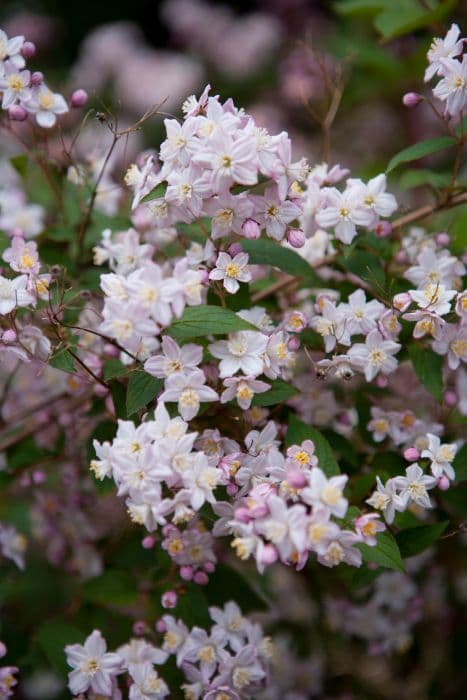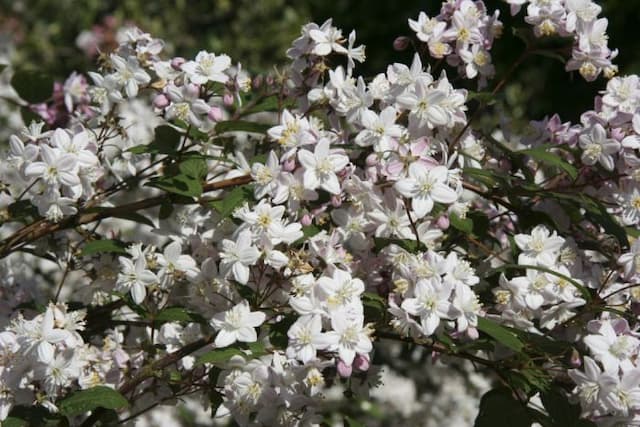Bigleaf Hydrangea Hydrangea macrophylla 'Sandra' (Dutch Ladies Series) (L)

ABOUT
The Hydrangea macrophylla 'Sandra', part of the Dutch Ladies Series, is a striking ornamental shrub known for its beautiful blossoms. This variety of bigleaf hydrangea features large, rounded clusters of flowers that bloom in a remarkable range of shades, depending on the soil's acidity. In alkaline soils, the flowers take on a more pinkish hue, while in acidic soils, they show off a rich blue color. The blossoms have a fluffy appearance, with numerous small individual flowers tightly packed together to form each globular inflorescence. These showy flower heads are quite bold and make a dramatic display against the backdrop of the plant's foliage. Speaking of leaves, this hydrangea showcases rich green, glossy leaves that provide a lush, dense canopy. The leaves have a broad, ovate shape with pointed tips and serrated edges, adding a textural dimension to the plant's aesthetic. As the seasons change, the bigleaf hydrangea 'Sandra' offers a long-lasting floral display, with blooms often lasting from early summer well into fall. The intense colors and full-bodied flower heads make this plant a favorite for gardeners looking to add a pop of color and elegance to their landscape. In addition to its visual appeal, this hydrangea can make an excellent cut flower, allowing its beauty to be brought indoors and enjoyed in floral arrangements. With proper care and the right conditions, the bigleaf hydrangea 'Sandra' remains a stunning focal point in gardens, attracting admiration from passersby and pollinators like butterflies and bees alike.
About this plant
 Names
NamesFamily
Hydrangeaceae.
Synonyms
Bigleaf Hydrangea, French Hydrangea, Lacecap Hydrangea, Mophead Hydrangea, Hortensia.
Common names
Hydrangea macrophylla 'Sandra'
 Toxicity
ToxicityTo humans
The common name for Hydrangea macrophylla is bigleaf hydrangea. Bigleaf hydrangea contains a compound called hydrangin, which is a cyanogenic glycoside. This can be toxic if ingested in significant amounts. Symptoms of poisoning typically include gastrointestinal upset, such as vomiting and diarrhea. In more severe cases, ingestion can lead to more serious symptoms such as dizziness, convulsions, and fast heart rate, largely due to the cyanide that can be released from the glycosides present in the plant. However, significant poisoning is rare since large quantities of the plant would need to be consumed to cause major toxicity.
To pets
Bigleaf hydrangea is similarly toxic to pets as it is to humans. If a pet ingests parts of bigleaf hydrangea, they could potentially experience symptoms of cyanide intoxication. The most common symptoms in pets after ingesting hydrangea include vomiting, diarrhea, and lethargy. In more severe cases, symptoms could potentially escalate to depression, labored breathing, and weakness. As with humans, significant toxicity in pets would typically require the consumption of large amounts of the plant.
 Characteristics
CharacteristicsLife cycle
Perennials
Foliage type
Deciduous
Color of leaves
Varies
Flower color
Varies
Height
4 feet (1.22 meters)
Spread
4 feet (1.22 meters)
Plant type
Shrub
Hardiness zones
6
Native area
Asia
Benefits
 General Benefits
General Benefits- Aesthetic Appeal - Adds vibrant color and visual interest to gardens and landscapes with its large, showy flowers.
- Long Blooming Season - Offers a lengthy display of blooms, typically from early summer to late fall.
- Versatility - Suitable for various garden styles, including formal, cottage, and container gardening.
- Pollinator-Friendly - Attracts bees and butterflies, supporting local ecosystems and pollination.
- Durability - Tends to be a hardy plant that can thrive in a range of conditions with proper care.
- Seasonal Interest - Foliage and flowers provide visual interest throughout the growing season, and some varieties offer attractive autumn leaf color.
- Ease of Cultivation - Though it requires attention to soil pH, it is relatively easy to grow for gardeners of different skill levels.
- Soil Improvement - Helps to build healthier soils by adding organic matter when leaves and flowers decompose.
- Variety - Comes in a range of colors and forms, allowing gardeners to choose the perfect fit for their landscape theme.
 Medical Properties
Medical PropertiesThis plant is not used for medical purposes.
 Air-purifying Qualities
Air-purifying QualitiesThis plant is not specifically known for air purifying qualities.
 Other Uses
Other Uses- The spent blooms of hydrangeas can be dried and preserved for use in floral arrangements, providing a long-lasting decoration many months beyond their natural blooming season.
- Hydrangea leaves can be used to create a natural green dye for fabrics, yarn, or paper, giving a soft green color when the dyeing process is applied.
- The woody stems of hydrangeas, when dried and treated properly, can be crafted into small implements such as garden stakes or labels, due to their robust nature.
- Artists may use the varied colors of hydrangea blooms as inspiration for artworks, capturing the gradient of colors in paint or other mediums.
- Dried hydrangea petals can be added to potpourri mixtures, contributing a subtle fragrance and texture to the blend.
- In educational settings, different parts of the hydrangea plant can be used to teach children about plant biology, including flower structure and plant lifecycle.
- Hydrangeas can be a subject for botanical illustration, where artists meticulously draw or paint the flowers in detail for scientific records or aesthetic prints.
- The pH sensitivity of hydrangea flowers, which influences their color, can be utilized in school science projects to demonstrate how soil conditions affect plant characteristics.
- Landscape designers often use hydrangeas for their versatility and range of colors to create focal points or complement other garden plants in landscape schemes.
- The bark of hydrangeas may be used as a natural mulch or compost ingredient, providing an organic way to enhance soil quality when it breaks down.
Interesting Facts
 Feng Shui
Feng ShuiThe hydrangea is not used in Feng Shui practice.
 Zodiac Sign Compitability
Zodiac Sign CompitabilityThe hydrangea is not used in astrology practice.
 Plant Symbolism
Plant Symbolism- Heartfelt Emotions: Hydrangeas often symbolize deep feelings and heartfelt emotions, expressing gratitude, understanding, and apology.
- Vanity: In certain cultures, hydrangeas represent vanity and boastfulness, possibly due to their abundant round-shaped flowers and tendency for varied colors.
- Gratitude for Understanding: Some narratives suggest hydrangeas convey a message of thankfulness to someone who has shown deep understanding towards another.
- Fourth Wedding Anniversary: Hydrangeas are traditionally given on fourth wedding anniversaries to symbolize appreciation and enduring love.
- Abundance: The lavish, full blooms of the hydrangea represent abundance and prosperity.
 Water
WaterBigleaf hydrangeas, including Hydrangea macrophylla 'Sandra', prefer consistently moist soil, so it's advisable to water them deeply once or twice a week, depending on weather conditions and soil drainage. A good rule of thumb is to provide about 1 gallon of water per watering session for each plant, especially during the growing season. During hot or dry periods, increase watering frequency to maintain soil moisture. It's best to water at the base of the plant to avoid wetting the foliage, which can lead to fungal diseases. In the winter, reduce watering as the plant goes dormant and requires less moisture.
 Light
LightBigleaf hydrangeas like Hydrangea macrophylla 'Sandra' thrive in partial shade, where they can receive morning sunlight and afternoon shade. The ideal spot would be an area that avoids the intense heat of the midday sun, which can scorch their leaves. They can also adapt to full morning sun with dappled afternoon light, making an eastern exposure a suitable location for these plants.
 Temperature
TemperatureThe bigleaf hydrangea, including Hydrangea macrophylla 'Sandra', grows best in temperatures between 65°F and 75°F. They can survive minimum temperatures down to about 20°F but should be protected from frost to prevent damage to the buds and leaves. It's imperative to avoid exposure to temperatures above 80°F for prolonged periods, as excessive heat can stress the plant.
 Pruning
PruningPruning a bigleaf hydrangea like Hydrangea macrophylla 'Sandra' is essential to maintain its shape and encourage blooming. Prune immediately after flowering, as the plant blooms on old wood. Remove only dead or weak stems, being careful not to cut back too much, which could reduce next year's blooms. Pruning is typically done annually, but if the plant is well-maintained, extensive pruning might not be necessary every year.
 Cleaning
CleaningAs needed
 Soil
SoilFor Hydrangea macrophylla 'Sandra', the best soil mix is rich, porous, and consistently moist but well-draining. It should contain a mixture of peat, compost, and garden soil to retain moisture and nutrients. This hydrangea prefers a soil pH that affects bloom color; for blue flowers, the pH should be acidic (5.2-5.5), and for pink flowers, it should be more alkaline (above 6).
 Repotting
RepottingBigleaf hydrangeas like Hydrangea macrophylla 'Sandra' should be repotted every 2-3 years or when they outgrow their current pot. Younger plants may require more frequent repotting, whereas established, larger shrubs may be repotted less often.
 Humidity & Misting
Humidity & MistingHydrangea macrophylla 'Sandra' thrives best in moderate to high humidity levels. Aim for a humidity level between 50% and 60% to keep the plant happy and to prevent the leaves from drying out.
 Suitable locations
Suitable locationsIndoor
Place in bright indirect light and keep soil moist.
Outdoor
Plant in partial shade, water regularly, and shelter from wind.
Hardiness zone
6-9 USDA
 Life cycle
Life cycleThe life cycle of Hydrangea macrophylla 'Sandra', commonly known as Bigleaf Hydrangea, begins with germination where the seed develops into a seedling under appropriate moisture and temperature conditions. As it matures into a juvenile plant, it forms a root system and foliage through vegetative growth. The plant enters the flowering stage during spring and summer, producing large, vibrant bloom clusters that can change color based on the soil pH. After pollination, typically by insects, the flowers produce seeds by late summer or fall, completing the sexual reproduction phase. Throughout the growing season, it experiences periods of growth and dormancy, with deciduous leaves shedding in the fall in colder climates. Finally, with proper care and cultivation, Bigleaf Hydrangea can live several years, during which it will repeat the flowering and seed production cycle annually.
 Propogation
PropogationPropogation time
Spring-Early Summer
Propogation: Hydrangea macrophylla 'Sandra', commonly known as the Bigleaf Hydrangea, is typically propagated through softwood cuttings. The best time to take cuttings is in late spring to early summer when the plant's new growth is still tender but mature enough to handle being cut and replanted. To propagate, a gardener would cut a 4 to 6-inch (10 to 15 cm) length of stem that includes several pairs of leaves. The lower leaves are removed, and the cut end of the stem may be treated with a rooting hormone to encourage root development. The stem is then inserted into a pot filled with moist, well-draining soil or a soilless potting mix. The cutting should be kept in a warm, humid environment out of direct sunlight until roots have developed, typically within a few weeks to a few months. Once the cuttings have rooted, they can be transplanted into individual pots or directly into the garden.








![Hydrangea [Early Sensation]](/_next/image?url=https%3A%2F%2Fplants-admin.emdemapps.com%2Fimages%2Fplants%2F%2Fimages%2F604b6150338db.png&w=640&q=75)
